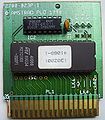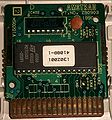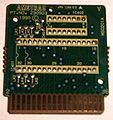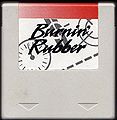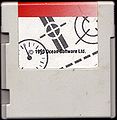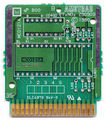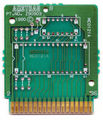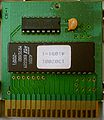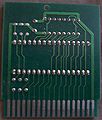(→Misc) |
|||
| (19 intermediate revisions by 4 users not shown) | |||
| Line 1: | Line 1: | ||
| − | [[Image:Burning Rubber - cara A.jpg|right|thumb|250px| | + | [[Image:Burning Rubber - cara A.jpg|right|thumb|250px|GX4000 Burnin' Rubber cartridge]] |
| − | A cartridge system was introduced with the launch of the | + | A cartridge system was introduced with the launch of the [[Plus]] and GX4000 series. This enabled developers to distribute games via cartridges on the new Amstrad. The cartridges are protected with the [[ACID]] chip. |
== EPROMs == | == EPROMs == | ||
| − | All known manufactured cartridges contain EPROMs (rather than PROMs or ROMs). The cartridges can be fitted with different EPROMs in range of | + | All known manufactured cartridges contain EPROMs (rather than PROMs or ROMs). The cartridges can be fitted with different EPROMs in range of 32kb through 512kb, but only 128kb to 256kb versions are known to have been produced. The cartridge PCBs typically include six [[LK Links]] to match the PCB to the EPROM pin-outs: |
VCC ---LK1--- EPROM.A18 ---LK2--- CA18 | VCC ---LK1--- EPROM.A18 ---LK2--- CA18 | ||
VCC ---LK3--- EPROM.A17 ---LK4--- CA17 | VCC ---LK3--- EPROM.A17 ---LK4--- CA17 | ||
| Line 12: | Line 12: | ||
(----- EPROM -----) (------------------------ Links installed -------------------------) | (----- EPROM -----) (------------------------ Links installed -------------------------) | ||
Type Pins Size A15 A17 A18 | Type Pins Size A15 A17 A18 | ||
| − | 27C256 28 32K LK5 (A15=VCC=High) | + | 27C256 28 32K LK5 (A15=VCC=High) LK3 (A17=VCC=Supply) N/A |
| − | 27C512 28 64K LK6 (A15=A15=Address) | + | 27C512 28 64K LK6 (A15=A15=Address) LK3 (A17=VCC=Supply) N/A |
27C1001 32 128K LK6 (A15=A15=Address) N/A LK1 (A18=VCC=/PGM) | 27C1001 32 128K LK6 (A15=A15=Address) N/A LK1 (A18=VCC=/PGM) | ||
| − | 27C2001 32 256K LK6 (A15=A15=Address) | + | 27C2001 32 256K LK6 (A15=A15=Address) LK4 (A17=A17=Address) LK1 (A18=VCC=/PGM) |
| − | 27C4001 32 512K LK6 (A15=A15=Address) | + | 27C4001 32 512K LK6 (A15=A15=Address) LK4 (A17=A17=Address) LK2 (A18=A18=Address) |
Some cartridge PCBs don't have any LKs installed, instead, the etched circuit has hardwired connections between some of them. One could scratch them off, and then use the LK soldering points to reconfigure the board for eproms of other size. | Some cartridge PCBs don't have any LKs installed, instead, the etched circuit has hardwired connections between some of them. One could scratch them off, and then use the LK soldering points to reconfigure the board for eproms of other size. | ||
== Protection == | == Protection == | ||
| − | The EPROMs aren't encrypted, making it very easy to dump their content, or to replace them by other EPROMs. However, all cartridges must contain an | + | The EPROMs aren't encrypted, making it very easy to dump their content, or to replace them by other EPROMs. However, all cartridges must contain an [[ACID]] chip, otherwise the [[Plus]]/GX4000 refuses to work, meaning that unlicensed third-party developers couldn't produce cartridges without buying the [[ACID]] hardware from Amstrad. |
| − | + | ||
| − | + | ||
| − | + | ||
| − | + | ||
== Pictures == | == Pictures == | ||
| Line 31: | Line 27: | ||
<gallery caption="2700-023P-1 (with hardwired LK1 and LK6, and single-sided soldering points)"> | <gallery caption="2700-023P-1 (with hardwired LK1 and LK6, and single-sided soldering points)"> | ||
Image:Cartridge-2700-023P-1-Components.jpg|Components | Image:Cartridge-2700-023P-1-Components.jpg|Components | ||
| − | Image: | + | Image:BurningRubberGX4000versionPCB.jpg|Components installed |
Image:Cartridge-2700-023P-1-Top.jpg|Component Side | Image:Cartridge-2700-023P-1-Top.jpg|Component Side | ||
Image:Cartridge-2700-023P-1-Bottom.jpg|Solder Side | Image:Cartridge-2700-023P-1-Bottom.jpg|Solder Side | ||
| Line 43: | Line 39: | ||
<gallery caption="PT-NO-Z90903-MC0121A (with custom LKs, and double-sided soldering points)"> | <gallery caption="PT-NO-Z90903-MC0121A (with custom LKs, and double-sided soldering points)"> | ||
| − | Image:Inside GX4000 cart 1.jpg|Components installed | + | Image:Inside GX4000 cart 1 unrotated.jpg|Components installed |
Image:Inside GX4000 cart 2.jpg|Solder Side | Image:Inside GX4000 cart 2.jpg|Solder Side | ||
| + | Image:Burning Rubber - cara A.jpg|Case Front (Component Side) | ||
| + | Image:Burning Rubber - cara B.jpg|Case Back (Solder Side) | ||
| + | Image:AMSTRAD CPC CARTRIDGE PT NO Z90903 B PARTSSIDE WITHOUT PARTS PCB SCAN ATV.jpg|Component Side (scan by ArcadeTV) | ||
| + | Image:AMSTRAD CPC CARTRIDGE PT NO Z90903 B SOLDERSIDE WITHOUT PARTS PCB SCAN ATV.jpg|Back side (scan by ArcadeTV) | ||
| + | </gallery> | ||
| + | |||
| + | <gallery caption="Spanish cartridge without text-layer on PCB (otherwise same as 2700-023P-1)"> | ||
| + | File:Dragon CPC Plus System Cartridge PC Spanish.jpg|Components installed | ||
| + | </gallery> | ||
| + | |||
| + | <gallery caption="AMSTRO1 (with hardwired LK1 and LK6, and double-sided soldering points)"> | ||
| + | File:Cart PCB AMSTRO1 top.jpg|Component Side | ||
| + | File:Cart PCB AMSTRO1 bottom.jpg|Solder Side | ||
| + | </gallery> | ||
| + | |||
| + | <gallery caption="Cartridge Slot"> | ||
| + | File:GX4000 Top.jpg|GX4000 with top-loading cartridge slot | ||
| + | File:CPC464Plus LeftSide Nighfallcrew.jpg|CPC Plus with side-loading cartridge slot | ||
</gallery> | </gallery> | ||
== Demonstration System == | == Demonstration System == | ||
| − | Amstrad released a Demonstration system for his retailer in order to show GX4000 games: the [[Amstrad CSD]]. | + | Amstrad released a Demonstration system for his retailer in order to show GX4000 games: the [[Amstrad CSD]] (Cartridge Software Demonstrator). |
| − | It was a | + | It was a 464 [[Plus]] motherboard, with an extra "daughter board" allowing the insertion of 12 games cartridges, plus an extra special cartridge acting as an OS. |
<gallery caption="Some photos of Amstrad Expo 90"> | <gallery caption="Some photos of Amstrad Expo 90"> | ||
| Line 61: | Line 75: | ||
Courtesy of Amstrad.cpc.free.fr | Courtesy of Amstrad.cpc.free.fr | ||
| + | |||
| + | More informations at the [[Amstrad CSD]] page. | ||
== Pin-Outs == | == Pin-Outs == | ||
| Line 70: | Line 86: | ||
* [[RAM7]], a French hardware developer, created a device to hack [[RAM7 Cartridge Hacker|CPC Plus cartridges]]. | * [[RAM7]], a French hardware developer, created a device to hack [[RAM7 Cartridge Hacker|CPC Plus cartridges]]. | ||
* [[CPC GX4000-Multi EPROM Cartridge]] | * [[CPC GX4000-Multi EPROM Cartridge]] | ||
| + | * [[Converted GX4000 Software]] | ||
==Links== | ==Links== | ||
| Line 78: | Line 95: | ||
[[Category:Hardware]][[Category:Cartridges| ]][[Category:DATA Storage]] | [[Category:Hardware]][[Category:Cartridges| ]][[Category:DATA Storage]] | ||
| − | [[Category: | + | [[Category:CPC Internal Components]][[Category:CPC History]][[Category:CPC Plus]] |
Latest revision as of 12:28, 23 March 2025
A cartridge system was introduced with the launch of the Plus and GX4000 series. This enabled developers to distribute games via cartridges on the new Amstrad. The cartridges are protected with the ACID chip.
EPROMs
All known manufactured cartridges contain EPROMs (rather than PROMs or ROMs). The cartridges can be fitted with different EPROMs in range of 32kb through 512kb, but only 128kb to 256kb versions are known to have been produced. The cartridge PCBs typically include six LK Links to match the PCB to the EPROM pin-outs:
VCC ---LK1--- EPROM.A18 ---LK2--- CA18 VCC ---LK3--- EPROM.A17 ---LK4--- CA17 VCC ---LK5--- EPROM.A15 ---LK6--- CA15
Usually the following LKs should be installed:
(----- EPROM -----) (------------------------ Links installed -------------------------) Type Pins Size A15 A17 A18 27C256 28 32K LK5 (A15=VCC=High) LK3 (A17=VCC=Supply) N/A 27C512 28 64K LK6 (A15=A15=Address) LK3 (A17=VCC=Supply) N/A 27C1001 32 128K LK6 (A15=A15=Address) N/A LK1 (A18=VCC=/PGM) 27C2001 32 256K LK6 (A15=A15=Address) LK4 (A17=A17=Address) LK1 (A18=VCC=/PGM) 27C4001 32 512K LK6 (A15=A15=Address) LK4 (A17=A17=Address) LK2 (A18=A18=Address)
Some cartridge PCBs don't have any LKs installed, instead, the etched circuit has hardwired connections between some of them. One could scratch them off, and then use the LK soldering points to reconfigure the board for eproms of other size.
Protection
The EPROMs aren't encrypted, making it very easy to dump their content, or to replace them by other EPROMs. However, all cartridges must contain an ACID chip, otherwise the Plus/GX4000 refuses to work, meaning that unlicensed third-party developers couldn't produce cartridges without buying the ACID hardware from Amstrad.
Pictures
- 2700-023P-1 (with hardwired LK1 and LK6, and single-sided soldering points)
- PT-NO-Z90903-MS0201A (with custom LKs, and single-sided soldering points)
- PT-NO-Z90903-MC0121A (with custom LKs, and double-sided soldering points)
- Spanish cartridge without text-layer on PCB (otherwise same as 2700-023P-1)
- AMSTRO1 (with hardwired LK1 and LK6, and double-sided soldering points)
- Cartridge Slot
Demonstration System
Amstrad released a Demonstration system for his retailer in order to show GX4000 games: the Amstrad CSD (Cartridge Software Demonstrator).
It was a 464 Plus motherboard, with an extra "daughter board" allowing the insertion of 12 games cartridges, plus an extra special cartridge acting as an OS.
- Some photos of Amstrad Expo 90
Courtesy of Amstrad.cpc.free.fr
More informations at the Amstrad CSD page.
Pin-Outs
Misc
- RAM7, a French hardware developer, created a device to hack CPC Plus cartridges.
- CPC GX4000-Multi EPROM Cartridge
- Converted GX4000 Software


